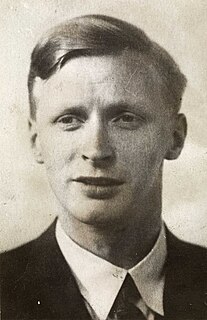Related Research Articles

Grini prison camp was a Nazi concentration camp in Bærum, Norway, which operated between 1941 and May 1945. Ila Detention and Security Prison is now located here.

Olav Dalgard was a Norwegian literary and art historian, filmmaker, author and educator.

Harald Grieg was a Norwegian publisher. He was director of Gyldendal Norsk Forlag and for many years was a leading figure in the Norwegian book industry.

Johannes Mathias Sejersted Bødtker CBE was a Norwegian banker, art collector and patron of the arts.

Otto Nielsen was a Norwegian songwriter, revue writer, cabaret singer and radio personality. He participated in Norwegian cultural life for five decades, starting from the 1930s, and played an important role behind the scene as program manager for the radio program series "Søndagsposten" for over twenty years.
Per Jacobsen was a Norwegian figure skater, and a resistance member who was killed during World War II.
Eiliv Skard was a Norwegian classical philologist.
Harald Krabbe Schjelderup was a Norwegian physicist, philosopher and psychologist. He worked with all three subjects on university level, but is best remembered as Norway's first professor of psychology.

Anatol Heintz was a Russo-Norwegian palaeontologist.
Arne Laudal was a Norwegian military officer, Milorg pioneer and resistance fighter during World War II. He was arrested by the Germans, sentenced to death and executed.

Julius Hougen was a Norwegian jurist and radio personality. He became known as the voice from Sørlandet over a period of more than forty years, eventually as a leader of the Norwegian Broadcasting Corporation's district office in Kristiansand.
"Vi vil oss et land" is a famous phrase in the context of Norwegian nationalism, derived from a poem by Per Sivle. It has been evoked by many different groups, including during the occupation of Norway by Nazi Germany, when an arrest order was issued on the deceased Sivle.
Sylvia Salvesen was a member of the high society in Norway, and a resistance pioneer during World War II. She was arrested and sent to the Ravensbrück concentration camp in Germany. She witnessed at the Hamburg Ravensbrück Trials in 1946, and wrote a memoir book documenting her wartime experiences.
Kirsten Brunvoll, née Sørsdal was a Norwegian playwright, resistance member, Nacht und Nebel prisoner, World War II memoirist and politician for the Labour Party.
Englandsfarere is a 1946 Norwegian war film directed by Toralf Sandø, starring Knut Wigert and Jørn Ording.
Alfred Zeidler was a German Schutzstaffel (SS) officer who served Nazi Germany in World War II. From 1942 to 1945, he was Lagerkommandant of the Grini detention camp in Norway during the German occupation. Although sentenced to lifelong forced labour after the war, Zeidler was released in 1953. Details of his later life are unknown.

Nils Mauritz Hald was a Norwegian actor.

Ragnhild Fjermeros Hald was a Norwegian actress.

Oscar Egede-Nissen was a Norwegian actor. He appeared in dozens of films from his debut in 1936 onward, his last being An-Magritt in 1969.
Om kjærligheten synger de is a Norwegian film from 1946. It was directed by Olav Dalgard and starred Harald Heide Steen in the lead role. The film deals with poverty in Oslo in the 1930s. The film premiered at the Klingenberg Cinema on October 30, 1946.
References
- ↑ Gunnar Iversen (2005). "Kampen om tungtvannet / Operation Swallow". In Soila, Tytti (ed.). The Cinema of Scandinavia. London: Wallflower Press. p. 97.
- ↑ Iversen, Gunnar (March 20, 2012). "En av de store i filmhistorien". Rushprint. Retrieved August 3, 2019.
- ↑ Kvalvik, Bent (2016). "De første norske filmene om krigen". Aftenpostens historiemagasin. No. 5. p. 108.
- ↑ "Vi vil leve". Norsk filmografi. Retrieved August 5, 2019.